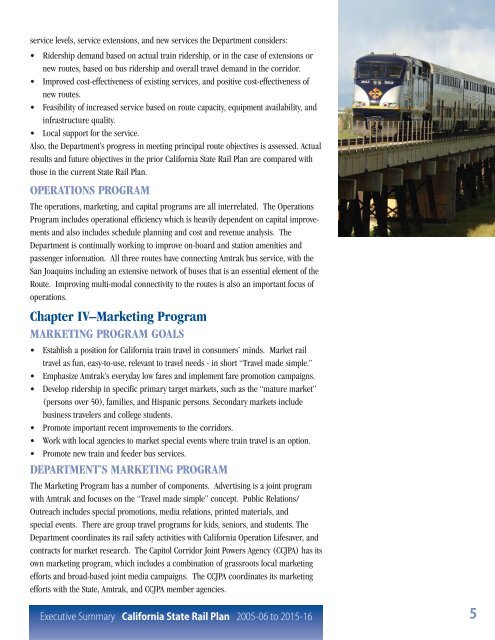California State Rail Plan 2005-06 to 2015-16
California State Rail Plan 2005-06 to 2015-16
California State Rail Plan 2005-06 to 2015-16
Create successful ePaper yourself
Turn your PDF publications into a flip-book with our unique Google optimized e-Paper software.
service levels, service extensions, and new services the Department considers:<br />
• Ridership demand based on actual train ridership, or in the case of extensions or<br />
new routes, based on bus ridership and overall travel demand in the corridor.<br />
• Improved cost-effectiveness of existing services, and positive cost-effectiveness of<br />
new routes.<br />
• Feasibility of increased service based on route capacity, equipment availability, and<br />
infrastructure quality.<br />
• Local support for the service.<br />
Also, the Department’s progress in meeting principal route objectives is assessed. Actual<br />
results and future objectives in the prior <strong>California</strong> <strong>State</strong> <strong>Rail</strong> <strong>Plan</strong> are compared with<br />
those in the current <strong>State</strong> <strong>Rail</strong> <strong>Plan</strong>.<br />
OPERATIONS PROGRAM<br />
The operations, marketing, and capital programs are all interrelated. The Operations<br />
Program includes operational efficiency which is heavily dependent on capital improvements<br />
and also includes schedule planning and cost and revenue analysis. The<br />
Department is continually working <strong>to</strong> improve on-board and station amenities and<br />
passenger information. All three routes have connecting Amtrak bus service, with the<br />
San Joaquins including an extensive network of buses that is an essential element of the<br />
Route. Improving multi-modal connectivity <strong>to</strong> the routes is also an important focus of<br />
operations.<br />
Chapter IV–Marketing Program<br />
MARKETING PROGRAM GOALS<br />
• Establish a position for <strong>California</strong> train travel in consumers’ minds. Market rail<br />
travel as fun, easy-<strong>to</strong>-use, relevant <strong>to</strong> travel needs - in short “Travel made simple.”<br />
• Emphasize Amtrak’s everyday low fares and implement fare promotion campaigns.<br />
• Develop ridership in specific primary target markets, such as the “mature market”<br />
(persons over 50), families, and Hispanic persons. Secondary markets include<br />
business travelers and college students.<br />
• Promote important recent improvements <strong>to</strong> the corridors.<br />
• Work with local agencies <strong>to</strong> market special events where train travel is an option.<br />
• Promote new train and feeder bus services.<br />
DEPARTMENT’S MARKETING PROGRAM<br />
The Marketing Program has a number of components. Advertising is a joint program<br />
with Amtrak and focuses on the “Travel made simple” concept. Public Relations/<br />
Outreach includes special promotions, media relations, printed materials, and<br />
special events. There are group travel programs for kids, seniors, and students. The<br />
Department coordinates its rail safety activities with <strong>California</strong> Operation Lifesaver, and<br />
contracts for market research. The Capi<strong>to</strong>l Corridor Joint Powers Agency (CCJPA) has its<br />
own marketing program, which includes a combination of grassroots local marketing<br />
efforts and broad-based joint media campaigns. The CCJPA coordinates its marketing<br />
efforts with the <strong>State</strong>, Amtrak, and CCJPA member agencies.<br />
Executive Summary <strong>California</strong> <strong>State</strong> <strong>Rail</strong> <strong>Plan</strong> <strong>2005</strong>-<strong>06</strong> <strong>to</strong> <strong>2015</strong>-<strong>16</strong> 5













